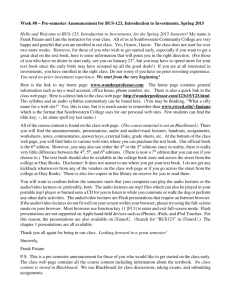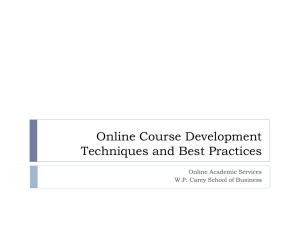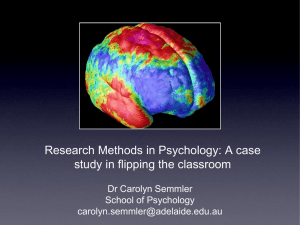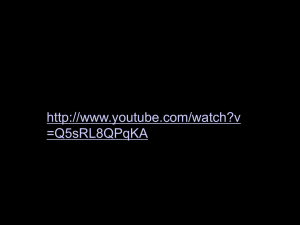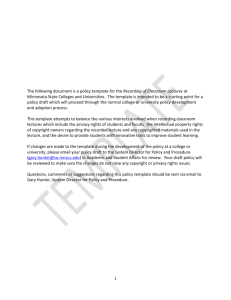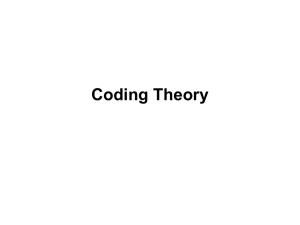COURSE CONTENT_Slides_1 - Kaunas University of Technology
advertisement
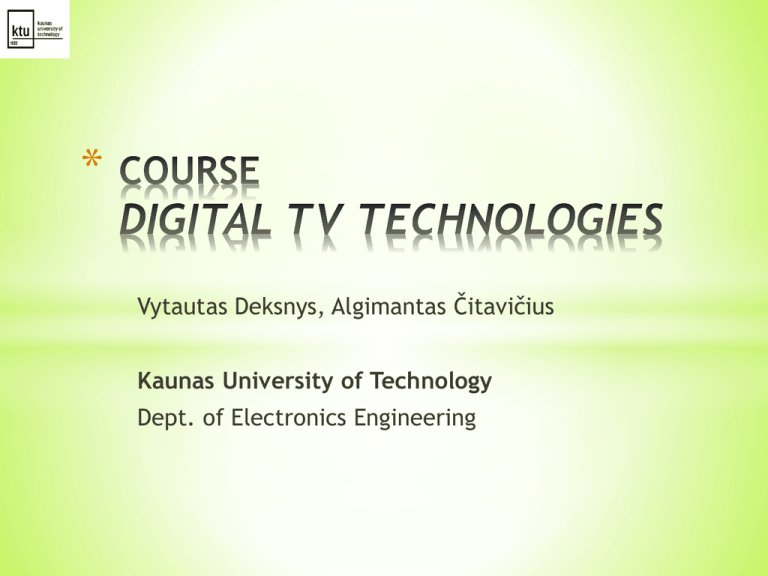
* Vytautas Deksnys, Algimantas Čitavičius Kaunas University of Technology Dept. of Electronics Engineering COURSE LECTURES CONTENT 1. HUMAN HEARING AND PERCEPTION • Human ear structure • Limits of hearing • Masking Time Masking Frequency Masking • The ear as spectrum analyzer COURSE LECTURES CONTENT 2. SPEECH PRODUCTION SYSTEM • • • The Human Voice Vowels and Consonants The Engineering Model 3. LINEAR PREDICTIVE ANALYSIS • Basic principles of linear predictive analysis • Optimal prediction coefficients • The autocorrelation method The Durbin‘s recursive procedure The minimal prediction error and effectiveness of prediction • The covariance method • The choice of parameters for linear predictive analysis COURSE LECTURES CONTENT 4. PULSE CODE MODULATION • • • • • • • • Sampling: Nyquist- Shennon sampling theorem Ideal sampling Aliasing and anti-aliasing Flat-top sampling Quantizing; Uniform quantizing Encoding Bandwidth of PCM signals Linear PCM advantages and disadvantages COURSE LECTURES CONTENT 5. SPEECH COMPRESSION • Necessity and possibility of compression • Nonuniform quantizing: µ-law and A-law companding • Adaptive quantization Maximum SNR coding Adaptation principle Types of adaptation Feed-forward adaptation Feed-backward adaptation • Differential quantization COURSE LECTURES CONTENT 6. SUB-BAND CODING PRINCIPLE 7. MPEG AUDIO LAYERS • • • • • Audio Layer 1 Audio Layer 2 Audio Layer 3 MPEG-2 Audio Advanced Audio Coding 8. VECTOR QUANTIZATION COURSE LECTURES CONTENT 9. SCRAMBLING • • Scramblers and PN sequence generators Frame synchronization 10.PHASORS, MODULATIONS, CONSTELATIONS • The phasor representation of a signal Geometric Interpretation • Modulation • Multilevel modulation and constellation diagrams COURSE LECTURES CONTENT 11.CONVOLUTIONAL CODES • Code parameters and the structure of the convolutional encoder • • • • • • • Encoder states Punctured codes Coding of an incoming sequence The encoder design State Diagram Tree Diagram Trellis Diagram COURSE LECTURES CONTENT • Decoding The basic idea behind decoding Sequential decoding Maximum Likelihood and Viterbi decoding * Kaunas University of Technology Prof. Vytautas Deksnys URL: http://www.msl.ktu.lt E-mail: Vytautas.Deksnys@ktu.lt Phone: +370698 48828 TS over IP (bidirectional) Ethernet 100M/1G (UDP & RTP) Control from PC Conv. DTM3200 DVB-ASI HDMI DVB-T/T2/C/ C2 STB DTA-115 Multi-Standard VHF/UHF (47 .. 862MHz ±1ppm) TV receiver * * Analyze all parts of DVB-ASI (MPEG2 TS) stream contents; * Investigate TS modulation according to the ETS 300 429 (QAM - Quadrature amplitude modulation) and ETS 300 744 (COFDM - Coded Orthogonal Frequency Division Multiplexing); * Investigate TS parts processing possibilities: - PID (Packet Identifier remapping); - EPG multiplexing; - PCR (Program Clock Reference) restamping; - service filtering; - NIT (network information table) generation; - PMT (program map table) monitoring; - PAT (Program Association Table) analysis; * Incomming transport stream bit rate measurement; * Analyze DVB-T/C set-top-box schematic (on STMicroelectronics SoC ST7105 basis) and FW architecture; * Analysis of HDMI interface (standard, signals, transfer rates, etc.). * * Investigation of phase noise influence on BER; * Investigation of channel noise and pulse disturbances influence on BER . *
